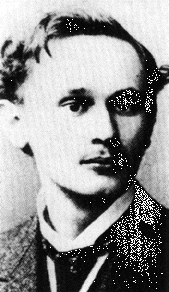Everyone who with directness and authenticity conveys that which drives him to creation, belongs to us.
ERNST LUDWİG KIRCHNER, 1906 MANIFESTO
On 7 June 1905 in Dresden, four German architecture students Fritz Bleyl, Erich Heckel, Ernst Ludwig Kirchner and Karl Schmidt-Rottluff founded the "The Artist" Group of the Bridge, or Die Brücke (The Bridge). The group would become one of the main forces of German Expressionism.
 |
| Ernst Ludwig Kirchner |
 |
| Erich Heckel |
 |
| Karl Schmidt-Rottluff |
The artists were young, idealistic and imbued with the belief that through painting they could create a better world for all. Their first manifesto, Programm, published as a broadside in 1906, contained Kirchner's call to arms:
"We call all young people together, and as young people, who carry the future in us, we want to wrest freedom for our actions and our lives from the older, comfortably established forces."
They saw their role to be revolutionaries, or prophets like the Nabis, rather than keepers of tradition. The name was chosen by Schmidt-Rottluff to symbolize the link, or bridge, they would form with art the future:
"To attract all revolutionary and fermenting elements: that is the purpose implied in the name 'Brücke'."
Emil Nolde joined the group for a few months after this letter being persuaded, between 1906 and 1907. The philosophical originality of the group and the usage of 'bridge' motif has also been linked to Nietzsche's book Thus Spake Zarathusta,1883.
Despite their utopian aims, the group was united more by what they disliked in the art around them. (anectodal realism and Impressionism)
The Brücke artists were aware of existing developments in France, and in 1908 an exhibiton of Henri Matisse's work in Berlin confirmed their enthusiasm for the Fauves. Their work shares certain visual characteristics (simplified drawing, exaggerated forms and bold, contrasting colours) and both groups insisted on the freedom of the artists to explain the meaning of sources in nature in individual ways. The first major influence on Die Brücke was Art Nouveau. In 1903 and 1904 Kirchner studied in Munich under one the leading designers of the Jugendstil (german Art Nouveau), Hermann Obrist, and an early street scene, Street,Dresden(1907-8) was painted.
Schmidt-Rottluff was the boldest colourist of the group, producing images in a disordant, forceful style. (e.g. Midday on the Moor, 1908).
By 1911 all of the members of the group moved to Berlin, and begun to go their seperate ways. Differences between the artists were beginning to be reflected in their works, as they moved away from the principles of style which had originally united them. Like the Fauve experiments in France, Die Brücke was indeed a bridge from Impressionism to Post-Impressionism to the art of the future which would assert its independence of means and expression through colour, line, form and two-dimensionality. As Kirchner wrote about Die Brücke:
"Painting is the art which represents a phenemenon of feeling on a plane surface. The medium employed in painting, for both background and line, is colour.... Today photography reproduces an object exactly. Painting, liberated from the need to do so, regains freedom of action... The work of art is born from the total translation of personal ideas in execution."
"We call all young people together, and as young people, who carry the future in us, we want to wrest freedom for our actions and our lives from the older, comfortably established forces."
They saw their role to be revolutionaries, or prophets like the Nabis, rather than keepers of tradition. The name was chosen by Schmidt-Rottluff to symbolize the link, or bridge, they would form with art the future:
"To attract all revolutionary and fermenting elements: that is the purpose implied in the name 'Brücke'."
Emil Nolde joined the group for a few months after this letter being persuaded, between 1906 and 1907. The philosophical originality of the group and the usage of 'bridge' motif has also been linked to Nietzsche's book Thus Spake Zarathusta,1883.
Despite their utopian aims, the group was united more by what they disliked in the art around them. (anectodal realism and Impressionism)
The Brücke artists were aware of existing developments in France, and in 1908 an exhibiton of Henri Matisse's work in Berlin confirmed their enthusiasm for the Fauves. Their work shares certain visual characteristics (simplified drawing, exaggerated forms and bold, contrasting colours) and both groups insisted on the freedom of the artists to explain the meaning of sources in nature in individual ways. The first major influence on Die Brücke was Art Nouveau. In 1903 and 1904 Kirchner studied in Munich under one the leading designers of the Jugendstil (german Art Nouveau), Hermann Obrist, and an early street scene, Street,Dresden(1907-8) was painted.
 |
| The Streer, 1907-8, Kirchner |
 |
| Am meer,1906, Schmidt-Rottluff |
Schmidt-Rottluff was the boldest colourist of the group, producing images in a disordant, forceful style. (e.g. Midday on the Moor, 1908).
By 1911 all of the members of the group moved to Berlin, and begun to go their seperate ways. Differences between the artists were beginning to be reflected in their works, as they moved away from the principles of style which had originally united them. Like the Fauve experiments in France, Die Brücke was indeed a bridge from Impressionism to Post-Impressionism to the art of the future which would assert its independence of means and expression through colour, line, form and two-dimensionality. As Kirchner wrote about Die Brücke:
"Painting is the art which represents a phenemenon of feeling on a plane surface. The medium employed in painting, for both background and line, is colour.... Today photography reproduces an object exactly. Painting, liberated from the need to do so, regains freedom of action... The work of art is born from the total translation of personal ideas in execution."
Hiç yorum yok:
Yorum Gönder